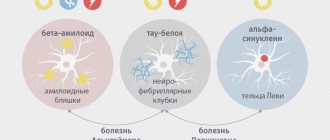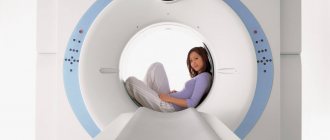Tests
Watch the video if you are too lazy to read
Watch the video if you are too lazy to read
- Rules
- Exercise
- Testing instructions
- Decoding the results
Alzheimer's disease is a neurodegenerative disease and the most commonly diagnosed form of dementia. The disease is named after the German scientist Alois Alzheimer, who was the first to describe the significant differences between dementia of neurodegenerative and vascular origin.
Alzheimer's disease is responsible for more than half of all diagnosed cases of dementia. At the same time, there is an increase in the number of cases around the world, mainly due to the aging of the world population.
Causes of Alzheimer's disease
© wildpixel / Canva
Work to establish the cause of Alzheimer's disease has been going on for many decades, but it is still not known for certain. There are only hypotheses, the most probable of which are the following:
- disturbances in the protein structures of neurons, complicating the transmission of signals between nerve cells and, ultimately, leading to their death.
- Infection of the brain by the bacterium Porphyromonas gingivalis, which lives in the oral cavity and causes gum disease.
- Accumulation of the beta-amyloid enzyme in the brain.
At the same time, factors that increase the likelihood of developing Alzheimer's disease are known for certain. The main ones are listed below:
- age;
- genetic predisposition;
- accumulation of aluminum in the body (in the brain in particular);
- arterial hypertension;
- smoking;
- overweight;
- diabetes;
- increased blood cholesterol levels;
- atherosclerosis.
Diagnosis of Alzheimer's syndrome
People experience memory problems due to various diseases. Symptoms may be temporary. caused by a lack of vitamins in the body or due to a side effect of a medication. It is not possible to detect Alzheimer's disease with one test. A comprehensive medical examination will be required to establish a diagnosis.
The doctor initially collects anamnesis and prescribes blood tests to rule out other causes of memory loss. A neurological examination and family medical history are performed. Testing is used to assess the state of the patient's memory and thinking. A mandatory method is neuroimaging - computed tomography and MRI of the brain, during which the structure, functions, and biochemical characteristics of the brain are examined.
Establishing an accurate diagnosis will help to implement treatment methods that will be effective and improve the quality of life of the elderly person.
Can Alzheimer's disease be cured?
© Ildar Imashev / Canva
Alzheimer's disease is a serious and incurable disease. As the disease progresses, a person develops cognitive impairment, worsens memory problems, develops speech disorders, executive functions, perception disorders, etc. At the stage of severe dementia, a person can no longer cope without outside help.
However, although Alzheimer's disease cannot be cured, modern medicine has methods that can stop or slow down the progression of the disease as much as possible. A responsible approach to the diagnosis and treatment of the disease allows a person to maintain cognitive functions until old age. Therefore, it is extremely important to identify signs of dementia at the earliest stages and consult a doctor in time for help. To do this, you need to know the symptoms of early manifestations of Alzheimer's disease.
Diagnostic methods
The first signs of Alzheimer's disease are cognitive impairment, which can be noticed even before diagnostic measures are taken:
- deterioration of the patient's memory;
- irritability;
- chronic apathy;
- causeless aggression;
- decreased thinking potential.
The diagnosis and treatment of such a disease is carried out by neurologists , who interview the patient before conducting instrumental examinations.
During such a survey, complaints are assessed and the level of dynamics of pathology development is determined. This allows you to make a preliminary diagnosis and differentiate Alzheimer's disease from other similar ailments.
MRI
The main research method for suspected development of Alzheimer's disease is an MRI of the brain .
This procedure is performed to visualize pathological changes that previously could only be determined after several years of disease progression.
MRI makes it possible to identify such a disease in the first stages of its development , after which additional procedures (CT, encephalography, ultrasound of the vessels of the brain and neck, and sometimes lumbar puncture) are performed for differentiation and final diagnosis.
To distinguish the disease from pathologies associated with the appearance of oncological formations in brain tissue, MRI is most often performed using a contrast agent, and a repeat procedure is prescribed a month later to compare and obtain accurate information about structural changes in tissue.
If Alzheimer's disease is suspected, the main indication for MRI is severe cognitive impairment, which manifests itself more clearly than the absent-mindedness and forgetfulness characteristic of old age.
When studying images obtained during an MRI , a specialist can determine whether the patient has a violation of the blood supply to the brain, changes in metabolic processes, expansion of the grooves and ventricles, as well as deformation of brain tissue and a decrease in its volume in general.
Clinical tests
In parallel with tomography for Alzheimer's disease, clinical tests are performed that make it possible to establish or exclude other pathologies leading to impaired cognitive functions in the patient.
Such analyzes include:
- general blood analysis;
- a blood test to determine the level of concentration of vitamin B12, the lack of which causes disruptions in the functioning of the nervous system;
- blood test for the level of folic acid, which is also necessary for the stable functioning of the nervous system and the formation of a sufficient number of leukocytes and red blood cells;
- analysis of glucose and electrolytes (these substances are necessary for normal brain activity);
- identifying the level of thyroid hormones produced by the thyroid gland (the absence of such hormones in the body in sufficient quantities can lead to cognitive impairment such as constant drowsiness, forgetfulness and clouding of consciousness).
Additionally, blood is drawn for testing for HIV : it has been scientifically proven that sometimes cognitive changes in personality can occur with such a diagnosis.
other methods
If the development of epileptic disorders is suspected, patients with Alzheimer's disease are prescribed an electroencephalogram (EEG) .
This test measures the level of electrical activity in the brain.
In rare cases, if during the patient’s lifetime it was not possible to diagnose Alzheimer’s disease with one hundred percent accuracy, an autopsy may be performed at the request of the relatives of the deceased.
During such a study, specialists can identify pathological changes in brain tissue that are characteristic of this disease.
How to diagnose Alzheimer's disease - MRI, CT, EEG studies:
Find out more about Alzheimer's disease:
- the causes and main symptoms of the disease, as well as the influence of heredity;
- differences in manifestations between men and women, young and old;
- the patient's life expectancy and the need for care;
- what drugs are used to treat the patient;
- Is it possible to prevent the disease?
Early symptoms and diagnosis of Alzheimer's disease
© Daisy-Daisy / Canva
When Alzheimer's disease develops, memory is the first to suffer. In this case, a person forgets recently occurring events or information received, while a person continues to remember events and knowledge acquired in the distant past well.
If you suspect Alzheimer's disease, you should consult a psychiatrist. The doctor will first ask the patient to take one of the cognitive tests. If, based on the test results, the doctor concludes that there are no impairments in cognitive functions, then the diagnosis will end, and the patient can be sure that at the moment he is not at risk of Alzheimer’s disease. If the test results are unsatisfactory, the doctor will refer the patient for more accurate examinations. In particular, the most accurate of them is brain imaging (magnetic resonance, computer, two-photon emission, etc.), which allows you to obtain layer-by-layer images of the brain and study its structure in great detail.
Cognitive tests that detect early Alzheimer's disease are simple and can be done at home. This is especially important given the fact that many older people refuse to see a doctor, unwilling to admit that they need help and treatment. Below are the most common tests and techniques practiced in clinics around the world.
From Elena Malysheva
Host of the TV show “Live Healthy!” Elena Malysheva, in the next episode of her program, advises the following simple test for the presence of Alzheimer's disease.
Malysheva asks subjects to answer the following questions:
- Have you ever had a time when you don't remember where you put your keys?
- Have you ever had a time when you simply cannot remember what happened a minute ago?
- Have you ever had a time when you raised your head, looked at the mirror and did not recognize yourself?
If the answer is “yes”, the presenter advises to press the red button, if “no” - the green button, if they do not understand what they are talking about - the yellow one. Those who press the red and yellow buttons should immediately contact a neurologist.
What tests to determine the first signs of senile dementia can be done at home in the video Elena Malysheva tells:
Puzzle tests
Text from letters and numbers
People with Alzheimer's disease have difficulty reading. The text in the picture below can be quickly read and understood the first time only by a person who does not have problems with fluent reading. If a person sees only a meaningless set of letters and numbers, he may have a predisposition to Alzheimer's disease.
Extra digit
This is an attentiveness test. Ask the subject to find a six among the nines.
A healthy person will find a six in less than a minute. If a person takes more than a minute to complete this test, they may have a predisposition to Alzheimer's disease.
Optical-spatial activity
To complete this test, you will need to copy the following drawing onto paper.
Invite the subject to draw arrows from number to letter in increasing order: that is, from number 1 to letter A, then to number 2, etc. If a person connects the circles in the following order: 1-A-2-B-3-C-4-D-5-D, and the arrows do not intersect, the test is passed. If a person makes a mistake and does not notice it himself, he may have a predisposition to Alzheimer's disease. In this case, we recommend using more detailed tests (you will find them below).
Mini-Cog test
© Robert Kneschke / Canva
The Mini-Cog test was developed at the University of Washington by Su Borson, an MD who specializes in dementia. The advantage of the test is its brevity and the ability to be performed by people who are not specialists in the medical field.
This short test is often used as part of the initial diagnosis of senile dementia of the Alzheimer's type and other types of dementia in older people. The Mini-Cog test allows you to evaluate a person’s short-term memory function, hand-eye coordination, and ability to perform tasks. It allows you to detect the development of Alzheimer's disease at the earliest stages.
Test rules
The test is quite simple and does not take more than five minutes. It consists of three actions:
- The subject is given 3 words: orange, window, pyramid. A person must repeat them and try to remember them.
- After which the subject must draw on paper a clock with hands indicating the time - twenty minutes to eleven.
- Then the subject must remember and name 3 words.
Scoring and evaluation of results
For each correctly named word after drawing a clock, the subject receives 1 point.
3 points
– no dementia.
1-2 points
if the clock is correctly depicted, there is no dementia.
1-2 points
If there are errors in drawing a clock, dementia is suspected.
0 points
– dementia is suspected.
Scientific basis for the effectiveness of the test
Although this test is used throughout the world for the initial diagnosis of Alzheimer's disease, there are studies confirming that the results of the Mini-Cog test cannot be fully trusted.
Researchers from the Department of Psychiatry at Queen's University in Kingston, Canada, conducted a meta-analysis examining four studies of the sensitivity and specificity of the Mini-Cog test for detecting Alzheimer's disease in primary care settings. These studies examined 1,517 cases in which the results of the Mini-Cog test were compared with the results of a diagnosis carried out in accordance with standard criteria for detecting Alzheimer's disease. According to the results of a meta-analysis published in 2018, the sensitivity of the Mini-Cog test varies from 76 to 100%. The scientists concluded that at the moment, including due to the small number of studies, there is insufficient evidence to recommend the Mini-Cog test for the primary diagnosis of dementia. You will find a link to the study at the end of the article.
Early diagnosis
SAGE, 6CIT, MoCA tests are necessary to identify Alzheimer's in the early stages and detect mild disorders. All of them are reliable and convenient elements for screening primary care patients and allow you to quickly and accurately identify pathological changes. The procedure is carried out in a calm environment, a quiet room, in the absence of a calendar or clock.
Important! When interpreting the results, one should take into account the level of education, intellectual abilities demonstrated throughout the previous life, and the age of the patient.
When creating the tests, the following criteria for Alzheimer's disease were taken into account:
- complaints of forgetfulness, memory problems;
- objectively identified amnestic disorders;
- general state of cognitive functions;
- activity in everyday life, society, interests, hobbies;
- absence of dementia.
MoCA
One of the best tests for Alzheimer's disease is the MoCA. According to studies, its specificity and sensitivity are 87% and 90%, respectively. Stands for Montreal Cognitive Rating Scale. Duration about 10 minutes. It is an eight-item questionnaire with a convenient designation of evaluation criteria. Thanks to this, a test to determine Alzheimer's disease can be done at home, but it is necessary to have an assistant present who will carry out the procedure itself and calculate the result. The maximum possible number of points is 30. On average, people without pathology score 27.4, with minor cognitive disorders - 22.0. The average result in the presence of asthma is 16.2 points. Using MoCA, memory, attention, concentration, abstract thinking, and spatial orientation are assessed.
SAGE
Test for early stages of Alzheimer's disease. Has high sensitivity. The probability of error is extremely low. The main advantage is the ability to perform it independently, without the participation of medical staff, which makes it easier to identify minor manifestations of pathology. Includes:
- “clock drawing” test;
- memory research tasks;
- checking orientation in space and time;
- study of frontal functions.
You can score a maximum of 22 points. A result from 17 to 22 indicates the absence of pathology; at 15-16, moderate cognitive impairment is recorded. 14 points and below - you should immediately seek advice from a neurologist.
6CIT
The 6CIT test for signs of Alzheimer's disease in women and men was developed in 1983. Repeatedly used in European studies, recommended by neurologists for determining mental activity. It has high sensitivity with good specificity (90% and 100%, respectively, for mild dementia - 78% and 100%). Duration of execution - 3-4 minutes, number of points - 6. The score is inverted - with smaller violations, the subject earns fewer points. Results: from 0 to 7 - no pathology, 8-9 - moderate disorders, 10-28 - severe disorders of brain function, a more in-depth examination is required.
Important! A diagnosis of Alzheimer's cannot be made based solely on test results. It should be confirmed by laboratory, instrumental, and, in later stages, neuroimaging methods.
Test "Drawing a clock"
© Peshkova / Canva
A very popular test for the initial diagnosis of Alzheimer's disease is drawing a clock face. This test is used in many methods of studying cognitive functions (including the Mini-Cog test described above).
The “Clock Drawing” test was developed more than a century ago – back in 1915. However, in those days it was used to diagnose aphasia and apraxia. It was only in 1989 that this test began to be used to diagnose cognitive impairment (link to material at the end of the article).
Exercise
Give the person a piece of paper and a pencil and ask them to draw a large round clock face with numbers and hands so that the clock indicates the time 11:10. The drawing is scored in points from 0 to 4. Only a result of 4 points is considered a sign of complete health. The lower the score, the more severe the Alzheimer's disease or other type of dementia.
Evaluating a drawing
To rate a drawing, add 1 point for each part:
1 point
for a vicious circle;
1 point
for depicting the numbers in the correct places on the dial;
1 point
for depicting all 12 numbers on the dial;
1 point
for correctly placed arrows.
Decoding the test result
Add up all points scored. If 4 points are scored, there is no dementia. Any result below 4 suggests Alzheimer's disease or another type of dementia. The more mistakes the subject makes in drawing a clock, the higher the severity of dementia.
Scientific basis for the effectiveness of the test
Scientists at University Hospitals Cleveland (Ohio, USA) conducted a study to determine the effectiveness of the Clock Drawing test for detecting Alzheimer's disease in the earliest stages, as well as to identify the most useful drawing elements for diagnosing this disease. The clock drawings of 41 patients over 39 years of age with MMSE test scores (presented below) of 24 points or higher were analyzed.
Based on the results of the study, scientists came to the conclusion that the most important diagnostic value is the image of the clock hands
. If you make two or more mistakes when drawing clock hands, there is a high probability of developing Alzheimer's disease in a person. In turn, the correct image of the clock hands does not exclude the possibility of developing Alzheimer's disease, but such a possibility is unlikely. You will find a link to the study at the end of the article.
Pass the online test with your watch
A clock test is very popular for detecting dementia, particularly Alzheimer's disease. It can be done online, at home.
The test is simple: the patient is given a piece of paper and a pencil, and asked to draw a clock so that the hands show 2 hours 45 minutes. The test is scored on a 10-point system. A score below 10 points is considered a disease.
Mini-Mental State Examination (MMSE)
©mail272/Canva
The Mini Mental State Examination (MMSE) is a short 30-point test that assesses the state of cognitive function and the degree of impairment. It is widely used in various clinics for the initial diagnosis of Alzheimer's disease, as well as for screening as it is treated.
MMSE was developed in 1975 by psychiatrists Marshall Folstein, Susan Folstein and Paul McHugh. Since then, this test has undergone minor changes, and is still used today in clinics around the world.
If anyone in your family complains of problems with short-term memory, concentration, mental arithmetic, speech, or other cognitive functions, suggest taking this test. It is quite simple and can be done at home.
Testing instructions
Orientation in time and space
The test subject must correctly name today's date, month, year, as well as the day of the week and time of year. Also, a person must correctly name his location: the name of the country, locality, region, house number or name of the institution, floor.
For each correct answer, 1 point is counted. For an incorrect answer - 0 points. Thus, the subject can receive from 0 to 10 points.
Perception
Ask the subject to remember three words that you tell him. Then say three words slowly and clearly: orange, window, pyramid (other option: apple, carpet, key). Then ask the person to say them.
For each word reproduced, 1 point is counted. Thus, the subject can receive from 0 to 3 points.
Concentration and mental arithmetic
Ask the subject to subtract the number 7 from the number 100 five times in succession (calculations must be done mentally). Thus, he must name 5 answers: 93, 86, 79, 72, 65. For each correct answer, count 1 point.
If the subject does not want to make calculations, offer another task: pronounce the word “EARTH” backwards. Score 1 point for each letter pronounced correctly. In other words, if the answer is correct, the subject must say “YALMEZ”, and he will be given 5 points. If the subject says “YAMLEZ”, only 3 points will be counted, etc.
Short-term memory
The subject must remember and say 3 words that you asked him to remember during the perception test. For each correct word, 1 point is counted. Thus, the subject can receive from 0 to 3 points.
Oral speech
Show the subject a wristwatch and ask him to name this item. Do the same with a stationery pen. For each correct answer, count 1 point.
Ask the subject to say the phrase “no ifs, ands, or buts.” If the phrase is pronounced without errors, count 1 point.
Thus, this task can be scored from 0 to 3 points.
Action in 3 stages
Give the subject a sheet of blank paper and say the following: “Take the sheet in your right hand, fold it in half and place it on the floor.” For each correctly performed action, count 1 point. The maximum number of points is 3.
Reading
Give the subject a piece of paper on which the command “CLOSE YOUR EYES” is clearly and legibly written, and ask him to do what is written on the sheet. If the subject closes his eyes, count 1 point.
Letter
Give the subject a blank sheet of paper and ask him to come up with and write down a meaningful sentence on any topic that will contain a noun and a verb. Spelling, grammatical and punctuation errors do not matter in this case. If the patient wrote a sentence, score 1 point.
Copying a drawing
Give the subject a blank sheet of paper and a sample drawing that shows two intersecting equiangular pentagons (as in the picture below). Ask to copy the drawing exactly. If the subject has drawn both pentagons, their lines are connected, and they intersect as in the sample, 1 point is counted. If one of the figures has more/less angles, the lines are open or the figures do not intersect, the point is not counted.
Test result evaluation
The result is calculated by summing the points scored for each test task. The maximum possible score is 30 points, which corresponds to a normal state of cognitive functions. The lower the total score, the more severe the degree of dementia. The result, depending on the amount of points scored, is interpreted as follows:
- 28 – 30 points:
cognitive abilities are normal. - 24 – 27 points:
there are cognitive impairments. - 20 – 23 points:
mild dementia. - 11 – 19 points:
moderate dementia. - 0 – 10 points:
severe dementia.
Scientific basis for the effectiveness of the test
Scientists at the University Foundation for Medical Sciences (Bogotá, Colombia) conducted a meta-analysis to investigate the effectiveness of the MMSE test for detecting Alzheimer's disease in people with mild cognitive impairment. The meta-analysis pooled and analyzed the results of 11 heterogeneous studies that examined data from 1569 patients with mild cognitive impairment.
In the meta-analysis, the researchers found no evidence to recommend the MMSE test as the sole diagnostic tool for identifying patients with mild cognitive impairment who are at risk of developing Alzheimer's disease. Doctors are recommended to use additional diagnostic methods in addition to the MMSE test. You will find a link to the study at the end of the article.
Tests for Alzheimer's disease
Alzheimer's disease is one of the most common neurodegenerative diseases found in older adults. It is important to notice the first signs of the disease in time and properly prepare for Alzheimer's disease. Tests for Alzheimer's disease can help you identify the problem yourself.
You may be interested in: How alcohol affects the brain in Alzheimer's disease Neuralgia - to heat or not to heat? 6 recipes for the treatment of neuralgia
Alzheimer's Disease Test: Memorize 5 Words
This is one of the classic tests that helps doctors suspect the presence of Alzheimer's disease in a patient. This test can be carried out at home, although you should strictly adhere to all the rules for conducting this test.
The patient needs to be read or given to read a list of any 5 words to remember. These words will need to be reproduced immediately and after 5 minutes (the patient should be warned about this).
Both times (with immediate and delayed reproduction), the patient is given a score from 0 to 5 points depending on the number of words reproduced. If the patient scores 9-10 points, then everything is fine. A score of less than 8 points indicates poor memory, possibly dementia.
If a person cannot remember a word, then he is given 2 hints. First, the person is prompted with a category, for example, if the word “orange” is forgotten, then the clue should be the word “fruit.” If the patient still cannot remember the word, then he should be given the opportunity to choose 1 word out of three, for example, “apple”, “orange”, “strawberry”. If the clues do not help, Alzheimer's disease may be suspected.
Alzheimer's disease test: draw a clock
One of the most commonly used tests to detect dementia (including Alzheimer's disease) is the clock test.
The patient is given a blank sheet of paper (without lines or cells) and a pencil (pen). The task is given: to draw a round clock dial, and place the hands so that they show fifteen minutes to three. This test is also scored out of 10 points, and a result below 10 may indicate the presence of certain problems with brain activity. So, let's evaluate the result of the work:
- 10 points – the norm, everything is drawn correctly;
- 9 points – minor inaccuracies in the location of the arrows were made;
- 8 points – errors in the location of the arrows are more noticeable;
- 7 points – the clock hands show completely wrong time;
- 6 points – the clock hands do not perform their functions (for example, the patient circled or squared some numbers);
- 5 points – the numbers on the dial are placed incorrectly (for example, different distances between different numbers);
- 4 points – there is no integrity of the watch, for example, some numbers are placed outside the dial;
- 3 points – the dial and numbers are not related to each other;
- 2 points – the patient cannot complete the task, although he tries to do it;
- 1 point – the patient does not even attempt to complete the assigned task.
You may be interested in: Alzheimer's disease and modern opportunities
Test for Alzheimer's disease and senile forgetfulness
With age, natural physiological changes occur in the nervous system, which negatively affect memory. It is important to determine in time whether memory decline is due to age or Alzheimer's disease. Below we give you signs that you should pay attention to.
When a person forgets events
- Senile forgetfulness. A person may forget some details, for example, he remembers that he went to the theater, in which row he sat, but does not remember the place.
- Alzheimer's disease. A person forgets all events (does not remember that he went to the theater).
When a person remembers something forgotten after a while
- Senile forgetfulness. Can often remember forgotten things after some time.
- Alzheimer's disease. A person rarely remembers events that he has forgotten.
Understanding your forgetfulness
- Senile forgetfulness. A person is aware of his forgetfulness, so he often asks strangers to clarify the details.
- Alzheimer's disease. A person is reluctant to accept facts indicating that he has forgotten something. Only after several categorical denials is it possible to recognize the fact of forgetfulness.
Speed and adequacy of speech
- Senile forgetfulness. Sometimes a person may not remember the names of people and rarely used words.
- Alzheimer's disease. A person has difficulty finding words, often replacing nouns with “this”, “this thing”, “what’s his name”, etc. The thread of reasoning is often lost, and the same tricks are repeated.
Reading and counting
- Senile forgetfulness. The person retains the ability to read and count.
- Alzheimer's disease. The person cannot read or count.
Decision making and action planning
- Senile forgetfulness. A person can follow instructions, as well as plan his own actions.
- Alzheimer's disease. A person cannot follow instructions and plan his actions.
Of course, these are not all the tests that can be used to determine dementia. The symptoms of Alzheimer's disease can be recognized by various picture tests and many other methods, but a final diagnosis is made only after examination by a doctor. At home, you can only suspect a pathology, which will be a reason to contact a specialist.
Arkady Galanin
The Alzheimer's Questionnaire
© Jivko / Canva
This questionnaire will help you determine whether someone close to you has Alzheimer's disease or whether there is no reason to worry. The test evaluates all of a person's abilities that are affected by the development of dementia. The questionnaire consists of 21 questions. For each affirmative answer, 1 or 2 points are counted, for a negative answer - 0 points. The higher the score, the higher the likelihood of dementia.
Memory
- Does your loved one have a bad memory? (Yes – 1, no – 0)
- If there are problems, have they gotten worse in recent years? (Yes – 1, no – 0)
- Does your loved one ask the same questions, repeat the same stories throughout the day? (Yes – 2, no – 0)
- Does he forget about planned activities or visits? (Yes – 1, no – 0)
- Does he lose things more than once a month? OR puts things in random places and then can't find them? (Yes – 1, no – 0)
- Does he express suspicions that things are being hidden, shifted or stolen from him when he finds it difficult to find them? (Yes – 1, no – 0)
Orientation in time and space
- Does your loved one often have difficulty remembering the time of day, today’s date, month, year? OR does he use the calendar or other sources several times a day to remember today's date? (Yes – 2, no – 0)
- Does he become disorientated in unfamiliar places? (Yes – 1, no – 0)
- Does he experience uncertainty and confusion when away from home or when traveling? (Yes – 1, no – 0)
Functionality
- Does your loved one have difficulty handling money, such as calculating change when shopping? (Yes – 1, no – 0)
- Does he have difficulty paying bills or handling finances? (Yes – 2, no – 0)
- Do his memory problems affect how regularly he takes his medications? (Yes – 1, no – 0)
- Does your loved one have difficulty driving? OR did he stop driving for reasons unrelated to physical limitations? (Yes – 1, no – 0)
- Does he have difficulty operating household appliances (microwave oven, stove, alarm clock, etc.)? (Yes – 1, no – 0)
- Does he have difficulty (not related to physical limitations) with chores? (Yes – 1, no – 0)
- Has your loved one given up or significantly reduced the time devoted to previous interests (sports, fishing, favorite craft, etc.) for reasons unrelated to physical limitations? (Yes – 1, no – 0)
Visuospatial orientation
- Does your loved one get lost in familiar places (not far from their own home)? (Yes – 2, no – 0)
- Does it happen that he chooses the wrong direction of movement? (Yes – 1, no – 0)
Speech
- Does it happen that your loved one cannot remember the appropriate words in a conversation (except names and titles)? (Yes – 1, no – 0)
- Does he confuse the names of family members or close acquaintances? (Yes – 2, no – 0)
- Does it happen that your loved one does not immediately recognize a person they know? (Yes – 2, no – 0)
Decoding the results
If you received less than 5 points
, this means your loved one does not have signs of dementia.
If the result is between 5 and 14 points
, your loved one should seek medical help because he has signs of mild cognitive impairment, which in the future may develop into dementia, incl. Alzheimer's type.
If you received more than 14 points
, it is likely that your loved one has already developed dementia and needs to seek medical help as soon as possible.
Development and scientific substantiation of the effectiveness of the questionnaire
In November 2010, a pilot project of the above questionnaire was published in the journal Alzheimer's Disease. Its development, analysis and research were carried out by a group of scientists with the support of the Banner Sun Health Research Institute (Arizona, USA) and a number of other scientific and medical centers. Scientists investigated the effectiveness and feasibility of using the above questionnaire for a more informative assessment of dementia.
During the study, the questionnaire was completed by informants of 188 patients, 50 of whom had normal cognitive abilities, 69 had mild cognitive impairment, and 69 were diagnosed with Alzheimer's disease. According to the results of the study, high sensitivity and specificity of this questionnaire was found to detect both mild and severe impairment of cognitive functions. At the same time, scientists noted that this questionnaire is not intended to completely replace the diagnostic examination of people with cognitive impairment. The full text of the study can be found at the link at the end of the article.










